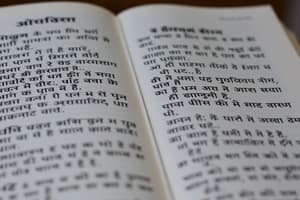Podcast
Questions and Answers
Which ancient texts served as a foundation for Hindi literature?
Which ancient texts served as a foundation for Hindi literature?
- Mahabharata and Andha Yug
- Suryakant Tripathi Nirala and Sahir Ludhianvi
- Aranyer Adhikar and Bhayanak Chandni
- Ramayana and Mahabharata (correct)
Which poet had a significant influence on modern Hindi literature?
Which poet had a significant influence on modern Hindi literature?
- Akhil Rajan
- Suryakant Tripathi Nirala (correct)
- Mohan Rakesh
- Mahasweta Devi
Which play explores the consequences of religious fanaticism in Hindi drama?
Which play explores the consequences of religious fanaticism in Hindi drama?
- Mahabharata
- Andha Yug (correct)
- Bhayanak Chandni
- Aranyer Adhikar
Who is known for their contribution to Hindi novels reflecting contemporary society?
Who is known for their contribution to Hindi novels reflecting contemporary society?
What kind of blend characterizes the unique grammar system of Hindi?
What kind of blend characterizes the unique grammar system of Hindi?
What aspect of India is deeply connected to modern Hindi poetry?
What aspect of India is deeply connected to modern Hindi poetry?
Which type of articles does Hindi have?
Which type of articles does Hindi have?
What unique conjugation system do Hindi verbs have?
What unique conjugation system do Hindi verbs have?
In Hindi grammar, what does it mean to be an ergative language?
In Hindi grammar, what does it mean to be an ergative language?
What gender distinctions do nouns and pronouns have in Hindi?
What gender distinctions do nouns and pronouns have in Hindi?
What is the typical word order in Hindi sentences?
What is the typical word order in Hindi sentences?
Why might Hindi allow word reordering in a sentence?
Why might Hindi allow word reordering in a sentence?
Flashcards are hidden until you start studying
Study Notes
Hindi: A Comprehensive Look at Grammar and Literature
Hindi, an Indo-Aryan language belonging to the Indo-European family, is the fourth-most spoken language in the world and the official language of India. It boasts a rich history, a venerable grammar system, and a flourishing literature scene. In this article, we'll dive into the nuances of Hindi grammar and the significant contributions of Hindi literature.
Hindi Grammar
Hindi grammar is a fascinating blend of simplicity and intricacy. Here are a few key points:
- Nouns and Articles: Hindi has three types of articles: definite (derived from the demonstrative pronouns), indefinite (derived from numerals), and zero articles. The definite article is usually omitted in modern spoken Hindi.
- Verbs: Hindi verbs have a unique conjugation system based on tense, person, and number. Hindi is an ergative language, meaning it has two subject types: the subject of the action and the subject of the verb's complement.
- Gender: Hindi is an inflected language, with nouns and pronouns having gender distinctions (masculine, feminine, and neuter). The gender of adjectives also depends on the gender of the noun they modify.
- Word Order: Hindi follows the Subject-Verb-Object word order, and the sentence structure is typically subject-predicate. However, Hindi also allows for word reordering to emphasize a specific element or create a more comprehensible sentence.
Hindi Literature
Hindi literature encompasses a diverse range of genres, from ancient epics to modern prose. Here are some highlights from the legacy of Hindi literature:
- Epic Poems: Ramayana and Mahabharata are two of the most ancient and revered texts written in Sanskrit, which also served as a foundation for Hindi literature. They were later translated into Hindi and continue to be read, performed, and celebrated to this day, influencing modern Hindi literature.
- Drama: Hindi drama dates back to the 16th century and is rich with cultural, social, and political themes, such as Andha Yug by Mohan Rakesh, which explores the consequences of religious fanaticism.
- Poetry: Hindi poetry, especially in its modern form, has a deep connection to the social, cultural, and political contexts of India. Poets like Akhil Rajan, Suryakant Tripathi Nirala, and Sahir Ludhianvi have greatly influenced modern Hindi literature.
- Novels: Hindi novels have evolved into an influential medium, reflecting contemporary society and championing social reforms. Mahasweta Devi's Aranyer Adhikar and Manjul Bajpayee's Bhayanak Chandni are two notable examples.
In conclusion, Hindi is a vibrant and dynamic language, brimming with intricacies and richness. The grammar system has a unique blend of simplicity and complexity, while its literature reflects the culture, society, and politics of India. As a result, Hindi continues to evolve and enrich the lives of millions of people, both in India and abroad.
Studying That Suits You
Use AI to generate personalized quizzes and flashcards to suit your learning preferences.




